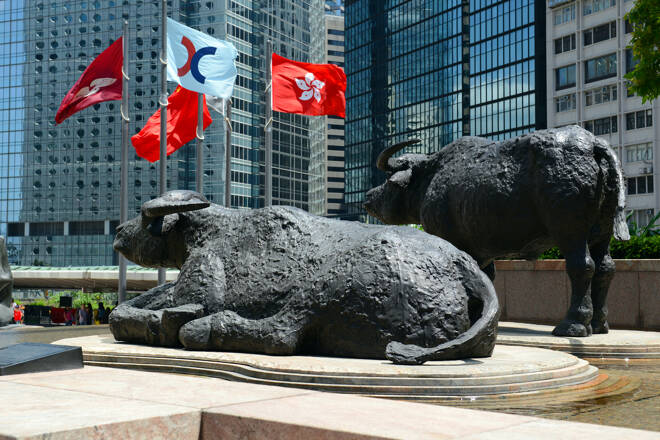Advertisement
Advertisement
Hang Seng Index, ASX200, Nikkei 225: Alibaba Sinks on SoftBank News
By:
It was a mixed morning, with the Hang Seng Index struggling as investors responded to the US CPI Report, FOMC meeting minutes, and today's news and stats.
- It was a mixed Thursday morning for the Asian markets, with the Hang Seng Index and ASX 200 seeing red while the Nikkei found early support.
- Softer US inflation figures and the FOMC meeting minutes delivered mixed signals.
- Economic data from Australia and China also drew interest this morning ahead of US wholesale inflation and jobless claims this afternoon.
Market Overview
It was a mixed morning for the Asian markets. The Hang Seng Index and the ASX 200 struggled, while the Nikkei found modest support despite a weaker USD/JPY.
This morning, investors reacted further to the US CPI Report, which sent mixed signals. While the annual inflation rate softened from 6.0% to 5.0%, the core inflation rate accelerated from 5.5% to 5.6%. On the plus side, inflationary pressures are cooling, suggesting that the Fed may be near the end of the monetary policy tightening cycle. However, inflation remains elevated, giving the Fed hawks a voice at the May meeting.
The FedWatchTool reflected mixed sentiment toward the March inflation figures. According to FedWatchTool, the probability of a 25-basis point interest rate hike fell from 72.9% to 65.2% overnight.
The expectation of a mild US recession added to the bearish mood. Within the FOMC meeting minutes, staff expect the recent banking developments to trigger a mild recession before recovering in the subsequent two years.
On Wednesday, the NASDAQ Composite Index fell by 0.85%, with the Dow and S&P 500 seeing losses of 0.11% and 0.41%, respectively.
After the bearish Wednesday session, the US futures sent bullish signals. The NASDAQ min and S&P 500 were up 20.75 points and 3.25 points, respectively. The Dow was down by just 4.
Trade data from China provided modest support following an unexpected surge in exports. Exports jumped by 14.8% in March versus a forecasted 7% decline. As a result, the dollar trade surplus narrowed from $116.88 billion to $88.19 billion. Economists forecast a narrowing to $39.2 billion.
ASX 200
The ASX 200 was down 0.25%, with mining and bank stocks weighing on the index.
Australian employment figures failed to provide support despite better-than-expected numbers. Full employment surged by 72.2k versus a forecasted 8k increase, with employment rising by 53.0k versus forecasts of a rise of 20.0k. The unexpected jump in employment left the unemployment rate at 3.5%. Economists forecasted an increase from 3.5% to 3.6%.
The big-4 had a mixed morning. ANZ Group (ANZ) and Westpac Banking Corp (WBC) saw gains of 0.59% and 0.07%, respectively. However, the Commonwealth Bank of Australia (CBA) and National Australia Bank (NAB) fell by 0.60% and 0.07%, respectively.
Oil stocks had a bullish morning. Woodside Energy Group (WDS) and Santos Ltd (STO) saw gains of 0.56% and 0.55%, respectively. Brent Crude was down 0.22% to $87.14 this morning.
However, mining stocks had a bearish morning. Rio Tinto (RIO) and BHP Group Ltd (BHP) were down by 0.28% and 0.76%, respectively, with Fortescue Metals Group (FMG) falling by 1.44%. Newcrest Mining (NCM) declined by 0.24%.
Hang Seng Index
The Hang Seng was down 0.53% this morning. Reports of SoftBank selling down its stake in Alibaba added to the bearish mood.
Considering the main components, Tencent Holdings Ltd (HK:0700) was up 0.22%, while Alibaba Group Holding Ltd (HK:9988) slid by 3.28%.
However, it was a bearish morning for banking stocks. HSBC Holdings PLC fell by 0.09%, with the Industrial and Commercial Bank of China (HK:1398) and China Construction Bank (HK: 0939) falling by 0.24% and 0.57%, respectively.
CNOOC (HK: 0883) was up by 2.44%.
Nikkei 225
The Nikkei 225 was up 0.71% this morning, despite a weaker USD/JPY.
Bank stocks struggled, with Sumitomo Mitsui Financial Group (8316) and Mitsubishi UFJ Financial Group seeing losses of 1.03% and 1.20%, respectively.
Looking at the main components, Fast Retailing Co (9983) rose by 1.43%, with KDDI Corp (9433) gaining 0.50%. However, Tokyo Electron Limited (8035) slid by 2.16%, with SoftBank Group Corp. (9984) and Sony Corp (6758) falling by 0.29% and 0.08%, respectively.
Expectations of a jump in Fast Retailing profits in response to the end of the zero-COVID policy in China delivered support.
Check out our economic calendar for today’s economic events.
About the Author
Bob Masonauthor
With over 28 years of experience in the financial industry, Bob has worked with various global rating agencies and multinational banks. Currently he is covering currencies, commodities, alternative asset classes and global equities, focusing mostly on European and Asian markets.
Did you find this article useful?
Latest news and analysis
Advertisement
